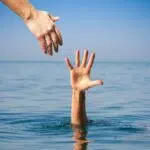National Drowning Prevention Day is held on July 25 every year as a means of raising awareness of the catastrophic and long-term effects of drowning on families and communities, as well as life-saving ways to prevent it. Every year, an estimated 236,000 individuals drown, and it is one of the top ten fatalities of kids aged five to 14. Toxicological studies show that children and adolescents from rural areas are more likely than urban dwellers to drown. Let’s take a deeper look at how to prevent drowning, particularly in children.
History of National Drowning Prevention Day
World Drowning Prevention Day, established in April 2021 by the United Nations General Assembly Resolution ‘Global drowning prevention’ is observed in July every year.
This global advocacy event provides an opportunity to highlight the devastating and profound impact that drowning has on families and communities, as well as to propose life-saving measures to help prevent it from happening again. An estimated 236,000 people drown each year, making drowning one of the top ten leading causes of death among children and adolescents aged one to 24 years.
Drowning disproportionately affects children and adolescents in rural areas, with more than 90% of drowning deaths occurring in rivers, lakes, springs, wells, and home water storage vessels in low- and middle-income nations.
World Drowning Day’s objectives include providing safe places away from water, such as childcare centers for pre-school children with capable childcare, teaching swimming, water safety, secured lifesaving skills, coaching bystanders in safe rescue and resuscitation, establishing and implementing safe boating, shipping, and ferry regulations, and improving flood risk management.
According to a recent U.N. General Assembly decision, the World Health Organization (WHO) has been requested to coordinate drowning prevention efforts across the whole United Nations system. WHO fulfills this role by planning a global launch event, generating relevant advocacy materials, and promoting national and local actions in nations and communities worldwide. It supports individuals and organizations in understanding the global context of drowning and drowning prevention, as well as in using the advocacy materials created for the event to improve what they are doing and inspire others in their networks to do the same.
National Drowning Prevention Day timeline
George Douglas Freeth establishes the first lifeguard training program at Redondo Beach, California.
The United States Military adopts mouth-to-mouth resuscitation.
California surf lifeguards establish the United States Lifesaving Association to improve lifesaving efforts and drowning prevention by standardizing beach lifeguard practices, educating the public about water safety and increasing professional standards among beach lifeguard organizations nationwide.
The World Health Organization (WHO) creates the “Global Report on Drowning.”
The World Health Organization (WHO) publishes “Preventing drowning: an implementation guide.”
National Drowning Prevention Day FAQs
How many people drown in the United States each year?
Children between the ages of one and four are the most likely to drown in their backyard swimming pools. Natural waters including lakes, rivers, and oceans account for more than half of all fatal and non-fatal drownings among people ages 15 and older.
What month is the most dangerous for drownings?
There are a large number of drownings and near-drownings in the late spring and summertime that is May through August.
What is the most common cause of drowning death?
The most common reason for drowning is a lack of swimming ability. It’s not uncommon for people of all ages to jump into the ocean without sufficient training. Drowning can be drastically reduced with proper water safety training and lessons taught by a lifeguard.
How to Observe National Drowning Prevention Day
Use the hashtag #DrowningPrevention
According to the World Health Organization, the hashtag #DrowningPrevention should be used on social media, particularly on National Drowning Prevention Day. This helps to broaden the event's reach.
Attend a training
As one of the major causes of death in children and young people, it is critical to receive training that will prepare you to know what steps to do next. The training will teach practical and lifesaving ways of avoiding drowning. You can also send your child or children to be trained.
Raise awareness
There are so many unsettling stats about drowning —most of which are preventable. So National Drowning Prevention Day raises awareness of drowning and how prevalent it can be especially among young people.
5 Shocking Facts About Drowning
It impacts children and adolescents
Drowning is one of the top ten killers of children and adolescents aged one to 24 worldwide.
Millions of deaths
Drowning has claimed the lives of more than 2.5 million people in the last decade, making it a major global problem that used to be mostly ignored.
Yearly estimate
The number of persons that drown each year is estimated to be 236,000.
Life jackets
Life jackets are designed to keep you afloat in water; they will automatically turn you face-up, keeping your mouth and nostrils clear of the water to prevent drowning.
Bathtubs
After pools, bathtubs are the second leading location where young children drown, however, buckets, bath seats, wells, cisterns, septic tanks, decorative ponds, and toilets are also potential drowning sources for infants and toddlers.
Why National Drowning Prevention Day is Important
It helps spread the word
National Drowning Prevention Day raises awareness of the deadly consequences of drowning. This day provides practical and lifesaving methods for preventing drowning, and the best part is that these may be shared both online and offline.
It encourages strict supervision of children
Barricades surrounding backyard pools are recommended because children can gain access to them without their parents' knowledge if there are no barriers in place. In any aquatic environment, including the bathtub, it is critical to provide adequate supervision.
Emergency training
It encourages more people to take training to know how to react during such emergencies and safeguard the lives of people affected by drownings. A lifeguard's instruction on water safety can significantly minimize the number of drownings that occur in the community.
National Drowning Prevention Day dates
| Year | Date | Day |
|---|---|---|
| 2025 | July 25 | Friday |
| 2026 | July 25 | Saturday |
| 2027 | July 25 | Sunday |
| 2028 | July 25 | Tuesday |
| 2029 | July 25 | Wednesday |























